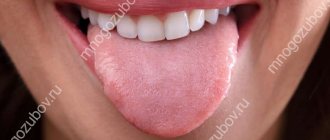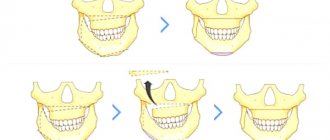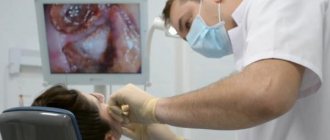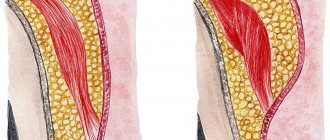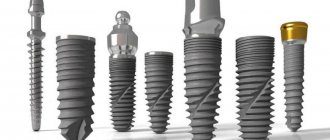Causes of inflammatory damage to the trigeminal nerve
Factors contributing to inflammation of the trigeminal nerve are:
- surgical interventions on the jaw bones;
- fractures of the base of the skull, lower and upper jaws;
- tumors;
- complex tooth extraction;
- hypothermia;
- surgery on the maxillary sinus;
- improperly administered anesthesia;
- incorrectly performed dental prosthetics;
- metabolic disorders;
- the presence of foreign bodies that irritate the nerve trunk or injure nerve endings;
- bacterial or viral infection;
- various types of intoxication of the body;
- hypovitaminosis;
- weakening of the immune system.
Types of disease
- Epidemic parotitis - in this case, intoxication of the body occurs due to viruses.
- Otitis media – Otitis media leads to perforation of the eardrum, causing infection in the facial nerve.
- Hunt's syndrome - a herpetic rash occurs on the anterior part of the tongue and ear. Due to the penetration of microbes, the salivary glands become inflamed, resulting in compression of the facial nerve.
- Merkenson-Rosenthal syndrome is a rare type of neuritis that is hereditary.
Symptoms of trigeminal neuritis
The maxillary trigeminal nerve consists of three types of nerve fibers:
- vegetative;
- motor;
- sensitive.
The symptomatic picture of neuritis may vary depending on which fibers were affected by the inflammatory process.
Damage to sensory fibers
In particular, with inflammation of the sensory fibers, the patient may complain of a tingling sensation, numbness, and weakened sensitivity in the area innervated by the trigeminal nerve.
Damage to motor fibers
When motor fibers are damaged, there is a partial or complete decrease in strength in the innervated muscles, their atrophy and deterioration of tendon reflexes.
Damage to vegetative fibers
When the vegetative fibers are inflamed, the patient experiences cyanosis and swelling of the skin, dryness and thinning of the skin, and the potential risk of developing a trophic ulcer increases.
Symptoms of facial nerve disease
If a person has a cold on the facial nerve, symptoms of the lesion appear in the form of unilateral or bilateral lesions. Often the affected part of the face (cheek, ear, chin) may become painful or numb. In 90 percent of cases, paresis is unilateral. The reason for this is that the temporal portion of the facial nerve is the most vulnerable.
Paresis (prosoparesis) is a decrease in voluntary movements of facial muscles. It has significant differences from paralysis. Paresis involves only partial impairment of muscle function.
The problem in diagnosing the disease is that paresis is not easy to notice (especially in mild forms of the disease). It only appears when a person speaks.
Paresis is divided into mild and severe. The mild form is characterized by minor changes in facial expressions in conversation. Severe paresis is a very indicative symptom of the disease. Such a defeat is expressed in the fact that the face turns into a mask. It is difficult for the victim to puff out his cheeks and close his eyes. Also, these movements are accompanied by pain.
Pathological synkinesis is divided into eyelid-labial and eyelid-frontal. In the first case, when the eyelid lowers, the corner of the mouth rises. In the second, when the eyelid droops, the forehead wrinkles.
The causes of paresis are:
- Fiber compression.
- Nerve damage.
The first reaction of neuritis is usually drooping of half the face and lacrimation.
Paralysis is also observed in the following:
- it is difficult for a person to speak;
- the victim has difficulty swallowing;
- the patient experiences lacrimation and salivation;
- there is a lack of sensation of taste of food;
- there are painful sensations in the face that are shooting in nature;
- the corners of the mouth and eyebrows (on the right or left side of the face) are lowered;
- difficulty closing your eyes;
- the victim feels pain in the ear, jaw;
- asymmetry of the facial muscles occurs;
- it is difficult for a person to whistle and puff out his cheeks;
- Sometimes the patient experiences eye twitching.
Thus, the main symptoms are expressed in high or reduced skin sensitivity; facial pain; malfunction of the salivary and lacrimal glands; numbness; pain inside the face (usually aching or dull); problems with facial expressions (reflected on the part that is cold).
Signs of the disease also differ depending on the phase. In the acute course of the disease, the lesion can be very visible, in this case the degree of facial distortion is very large.
Pain due to inflammation
In addition, a disease such as inflammation or neuritis of the facial trigeminal nerve makes itself felt with attacks of pain of a very diverse nature:
- cutting,
- burning,
- pricking,
- tearing
- shooting, etc.
In this case, the area of pain does not always correspond to the area of innervation and can spread to the lower jaw, cheeks and chin.
Pain may be accompanied by:
- muscle spasms (facial, chewing),
- the appearance of nasal discharge,
- development of hypersalivation,
- increased lacrimation.
Lack of sensation in the tongue, lips and chin
With inflammatory damage to the trigeminal nerve, not only the entire nerve can be damaged, but also its individual branches. This is why numbness and pain can occur in various areas of the face. For example, when the lingual branch of the nerve is inflamed, patients complain of pain and sensitivity disturbances in the anterior part of the tongue, and when the mental branch is damaged, in the area of the lips and chin.
Pain when laughing, chewing, brushing teeth and shaving
Pain due to neuritis of the maxillary trigeminal nerve can intensify with touching, chewing, laughing and with changes in temperature. That is why patients, trying to prevent the recurrence of painful attacks, avoid excessive mobility and prolonged conversations, and refuse brushing their teeth and shaving.
Causes of the disease
Coldening the facial nerve means giving access to pathogenic microbes into the body. They disrupt the supply of nerves to tissues. Statistically, in 90 percent of cases, when a person cannot control the movements of the facial muscles during a cold and experiences pain, this is a sign of a cold facial nerve.
The causes of the disease are also serious lesions, such as:
- head injury;
- middle ear disease;
- hypothermia;
- lesions during pregnancy;
- diabetes;
- borreliosis;
- spinal paralysis;
- damage to the central nervous system;
- tumors;
- ischemia;
- stroke;
However, most facial nerve paresis occurs due to hypothermia. Therefore, during the cold season, you need to be especially careful about yourself, dress warmly, and avoid hypothermia.
Treatment of neuritis of the maxillary trigeminal nerve
Therapy
The treatment program for trigeminal neuritis is drawn up taking into account the causes of the disease and its clinical signs. The main goals of treatment are:
- achieving a sensitizing effect;
- fight against bacterial and viral infection;
- increasing the body's immune forces;
- elimination of swelling of the nerve trunk;
- restoration of natural adaptive and compensatory reactions;
- normalization of the patency of nerve impulses.
Healing procedures
The set of procedures aimed at blocking the inflammatory process and eliminating all manifestations of neuritis includes:
- antibacterial therapy;
- antiviral therapy;
- elimination of factors contributing to the occurrence of intoxication;
- removal of tumor-like neoplasms or dissection of adhesions compressing the nerve;
- prescribing vitamin and mineral complexes to the patient;
- stimulation of nerves and muscles;
- acupuncture;
- physiotherapy (electrophoresis, phonophoresis, UHF, ultrasound, paraffin therapy).
People suffering from trigeminal neuritis are advised to regularly visit dental clinics and have their oral cavity sanitized.
How can you get a cold on the facial nerve?
The anatomical location of the facial nerve is quite confusing. It passes through the facial canal of the temporal bone and exits into the auditory canal. At this point it intersects with the intermediate nerve.
It is quite easy to get colds in the maxillofacial area. However, this disease is similar in symptoms to others. It is important not to self-medicate, but to consult a specialist in time.
The nervous system is complex. The skin and muscles are equipped with nerves that intersect with each other. When viruses damage the facial muscles of the face, neuritis or neuropathy of the facial nerve develops. Neuritis is inflammation of a nerve. Neuropathy is a disease that causes unilateral paralysis of the facial muscles.
Diagnostics
When the facial nerve is blown, at the first signs of the disease you need to consult a doctor, preferably a neurologist. Otherwise, the person may become increasingly worse. The diagnosis is often visible from the person's face. It's skewed, only one half moves. The asymmetry of movements of the left and right sides of the face is also visible.
Based on the patient’s story about how the facial nerve hurts, as well as on the visual picture, often an experienced doctor can make a diagnosis without additional examinations.
But since the cause of the development of facial neuritis is of great importance, the doctor often prescribes tests. After all, tumors and inflammation can be factors in the development of the disease, and the disease can also be a symptom of a stroke.
When making a diagnosis, the doctor also needs to determine the nature of the damage, i.e., the depth of the paresis.
What tests does the doctor prescribe:
- Complete blood count (finger prick). Together with other symptoms, this analysis may indicate meningitis, otitis media and other long-term illnesses.
- MRI. Very accurate method. Detects tumors, signs of heart attack, inflammation of the membranes of the brain, abnormal development of blood vessels.
- CT. A CT scan can also reveal certain symptoms that cause neuritis. These are tumors, brain hematomas, symptoms of a stroke.
- Electroneurography (study of the speed of an electrical signal that travels along a nerve), electromyography (study of electrical impulses arising in muscles).
How to quickly relieve facial swelling in adults
If this is physiological swelling of the face, not associated with serious pathologies that require medical supervision and the use of selected medications, excess fluid can be eliminated through certain simple measures and actions.
Taking a contrast shower or washing with cold/hot water. This method refreshes, increases tissue tone, enhances the outflow of fluid from the skin and reduces swelling.
Using ice – a couple of pieces of ice will help deal with swelling on the face quickly and effectively. In addition, you can prepare herbal decoctions with a tonic effect in advance and freeze them, using them for washing.
Facial massage is an effective remedy that helps improve microcirculation and swelling. Manual massage, the use of rollers, ice cubes, and cold spoons help. Sometimes you can first wipe your face with green tea and apply compresses with it to your face and eye area.
When is surgery used?
The help of a surgeon in treating the disease is needed only when other methods do not help. This happens infrequently, because with timely treatment the disease is well treated.
If surgery is prescribed, the surgeon’s actions involve destruction of the facial nerve. Special drugs are injected into the site of nerve damage to reduce its sensitivity and susceptibility.
Nerve fiber decompression is performed in difficult cases. During this, the doctor changes the position of the arteries located near the nerve. After this procedure, the discomfort does not go away immediately, but only after a few months.
Surgery should be resorted to only in extreme cases. It has negative features:
- Not every patient can tolerate general anesthesia;
- After the operation, a scar remains.
Complications
If neuritis is not treated, complications may begin. Namely:
- The paresis will turn into paralysis of the facial muscles. It will be completely immobilized.
- It will be impossible to completely close the eyelid (hare's eye).
- Other neuralgia may develop.
Also, a consequence of a cold facial nerve can be pain in the teeth, otitis media and even hearing loss.
Treatment methods
Self-medication is unacceptable here. When the doctor discovers that the facial nerve is cold, treatment usually begins without delay. For greater effectiveness, it is comprehensive.
Usually the doctor prescribes medications, including:
- Pharmaceuticals.
- Decongestant medications (they relieve swelling).
- Diuretics (remove excess moisture, dilate coronary vessels).
- Drugs that increase the sensitivity of nerve tissue.
- Substances to maintain muscle tissue in tone (preventing infection).
- Vasodilators (allow you to saturate the tissues with oxygen).
- Painkillers (relieve pain).
Usually, not only drug treatment is prescribed, but also special gymnastics, as well as physiotherapy. If necessary, antibiotics may be prescribed as part of complex therapy.
Important: therapeutic exercises are performed on the side that is not affected. In this case, relaxation and tension of the facial muscles alternate. Gymnastics is aimed at simulating the expression of various emotions (anger, laughter, joy, crying).
Articulatory sounds come to help in the training process.
It should be remembered that physiotherapy may have contraindications. Therefore, they are prescribed after a special examination.
Traditional medicine can also be used in complex therapy:
- Goat milk with honey before bed (the drink should be warmed before drinking).
- Flax seeds are steamed and applied to the painful area.
- Rubbing fir oil into the affected area.
- Rose tea (a drink made from red rose petals). The drink calms the central nervous system.
Many people are interested in the question of whether it is possible to heat the skin in the area of inflammation of the facial nerve. To combat the disease, you can use not only medications and therapeutic exercises. Dry heat can also be a way to relieve pain. But this method is controversial; it is better to use such treatment with the permission of a doctor.
Prevention
In windy, cold weather it is very easy to blow through a nerve. A pulling sensation on the face and soreness are symptoms that are difficult to tolerate. They interfere with normal productive life and work. For people who often catch colds, it is important to think about preventing the disease. It is easier to prevent inflammation of the facial nerve than to treat it. Preventive measures include:
- in the cold season, do not forget about hats;
- in cold weather, cover your face with a warm cloth, it can be a scarf;
- remember that drinking only cold drinks will cause colds in your teeth and throat; Because of this, neuralgia and neuritis may develop.
- treat any viral diseases that appear on the face;
- take care of yourself, especially during colds.
Neuritis of the facial nerve can be classified as a grateful disease, because it can be treated quite well. But the severity of the disease, as well as how quickly recovery occurs, depends on timely contact with a competent specialist.
Timely preventive measures are also important.
What diseases does it occur in?
First, you need to look for inflammation near the affected lymph node. Usually bacteria or viruses enter it from a nearby organ.
Diseases in which the cervical lymph node becomes inflamed:
- acute respiratory infections and acute respiratory viral infections;
- tonsillitis (acute or chronic);
- dental diseases (focus of infection in the mouth).
Enlarged inguinal lymph nodes are often associated with sexually transmitted diseases, including herpes infection. Axillary units are inflamed with hidradenitis - a pathology of the sweat glands.
Sometimes inflammation of the lymph node occurs against the background of a general weakened state of the body. This is observed in malignant neoplasms, blood pathologies, HIV infection and viral hepatitis B.
In a chronic specific inflammatory disease, an enlarged lymph node is a normal variant. This is a reaction to the underlying pathological process and does not require treatment.
Enlargement of more than one lymph node often indicates infection. This is how tuberculosis, syphilis, and tularemia manifest themselves. Inflammation of a large number of lymph nodes indicates a serious infectious process - HIV, toxoplasmosis, brucellosis, CMV, mononucleosis and others. This requires urgent consultation with an infectious disease specialist.


